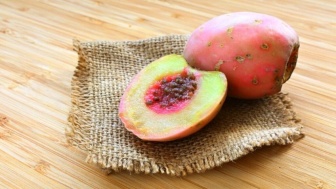Gastronomy of Guanajuato. Xoconostle, the star ingredient in your typical food
News Category: News, Food and Drink, and General Discussion
-
The typical food of Guanajuato includes a wide variety of dishes and flavors. But in the gastronomy of the state, there is a star ingredient: xoconostle.
Just as the term “a la poblana” refers to preparations that use poblano peppers, the term “a la guanajuatense” applies to recipes that include xoconostle.
According to the Diccionario Larousse Enciclopédico de la Gastronomía Mexicana, “a la guanajuatense” refers to a:
A term applied mainly to dishes containing xoconostle, due to the fact that this fruit is produced in abundance in the state of Guanajuato and is widely used in the ancient cuisine of the entity. Some dishes are the guanajuatense salad, pico de gallo, etcetera.
Xoconostle and the gastronomy of Guanajuato
This fruit is also known as peach, cat’s egg, joconol, sour tuna, yellow or orange xoconostle.The word xoconostle comes from Nahuatl, meaning xoco, sour and nochtli, tuna, that is, sour tuna.
When this fruit is unripe it is pale green and as it ripens it acquires a pink or purple color. It can remain on the cactus for up to a year without spoiling.
Unlike what happens with other prickly pears, all its seeds are concentrated in the center of the fruit and it is not customary to eat them.
The states of the center of the country and the Bajío use it in recipes such as mole de olla. In Guanajuato it is sometimes added to spicy sauces and broths.
In Guanajuato there are different varieties, there are xoconostles of white, red, green, yellow, pink-purple, and orange tones.
Depending on its color it will receive the name, so the green xoconostle is called cuaresmeño; the pink, like the rose of Castile, and the red, bull’s blood. It is available all year round because it can be buried in the sand to preserve it.
According to the Larousse dictionary:
Guanajuato presents a great use of this fruit in its gastronomy. In Ocampo, there is a small variety that is produced and consumed locally. In Dolores Hidalgo, a salad is prepared with xoconostle, jicama, orange, cheese, and green chile piquín. In Ciudad Victoria xoconostle is abundant; in Coroneo it is grown and consumed a lot and from there it is sent to Querétaro and Mexico City.
There are countless varieties of pico de gallo sauce in which it is used, as well as in salads, such as the guanajuatense salad. It is also added as a vegetable to marrow soup, shrimp broth, beans, green pipian, and pipian with xoconostle; different specialties are prepared with it, such as maguey stalk stuffed with xoconostle, xoconostle with potatoes and xoconostles in chile guajillo in beef; sauces such as xocochile, chile with xoconostle, chile molcajeteado with xoconostle, xoconostle with tomato, xoconostle with green chile and salsa borracha with xoconostle.
In addition, sweets or desserts are prepared such as xoconostle compote, xoconostles in syrup, xoconostle jam, xoconostle water; the xoconostle jam made in Guanajuato can be considered a jam previously soaked in lime and then cooked in water with sugar.
Other typical dishes of Guanajuato
In the list of typical dishes of Guanajuato, there are antojitos, desserts, very Mexican sweets, and traditional products such as cajeta from Celaya or strawberries from Irapuato.Irapuato strawberries are used to prepare jams and preserves, atoles, desserts, and even tamales.
According to the Larousse Dictionary of Mexican Gastronomy, the typical food of Guanajuato includes dishes such as artichokes from the hacienda, barbacoa, baked kid and in its blood, caldo michi, chilaquiles, chiles de chorro rellenos (stuffed chiles), empanadas, enchiladas rojas, ilustradas and mineras, fiambre, frijoles puercos, gorditas de maíz quebrado, guacamayas, menudo, mojarra empanizada, nopales con chile guajillo, nopales rellenos, pacharelas, pollo en cuñete, puchero, quesadillas or carnitas empanadas, revoltijo (romeritos), garlic soup, tacos de nata and mineros, ash and chickpea tamales, chard tamalón, tostadas de cueritos, totoposte and uchepos de sal and de leche.
The Otomí culture is present through the pumpkin candy with piloncillo, pacholas, pintaderas, tamale soup and tortitas pintadas.
We share with you the most famous dishes within the typical food of the state of Guanajuato:
- Enchiladas mineras: prepared with corn tortillas, ranchero cheese, onion and chile guajillo, and tomato sauce; they are usually accompanied by potatoes.
- Dishes prepared with xoconostle: shrimp broth, capon, beef tail, guanajuatense salad, pipian, vegetable soup, marrow soup, sauces, xocochile.
- Gorditas de carnitas: which can be tasted in Dolores Hidalgo.
- Guacamayas: with pork rinds and sauce; they are typical of Leon.
- Nieves tipicas: they are traditional from Dolores Hidalgo, there is a great variety of flavors to enjoy.
- Capone de nopales con Xoconostle, a typical dish of Otomí cuisine.
- Cebadina: a typical drink from Leon prepared with barley and fruits.
- Penca rellena: typical of the community of Valtierrilla in Salamanca.
- Tumbagón: a typical sweet from San Miguel de Allende.
- Pan de Acámbaro: this type of traditional bread has already been designated as a collective brand.
- Gorditas horneadas: traditional in the northern part of Guanajuato.
- Caldo de Oso: it contains pineapple vinegar, lemon, chopped onion, salt, chile, and grated cheese.
- Jamoncillo de Leche: a sweet that can be decorated with nuts or almonds. It is commonly consumed in popular festivals or local fairs.
- Charamuscas: Figurines made of caramel, which originally had the shape of a twisted churro, but the ingenuity of the Mexican has managed to obtain different shapes. It is prepared with piloncillo boiled in water.
This content was created with information from the government of Guanajuato and the Larousse Dictionary of Gastronomy.


Leave a Reply